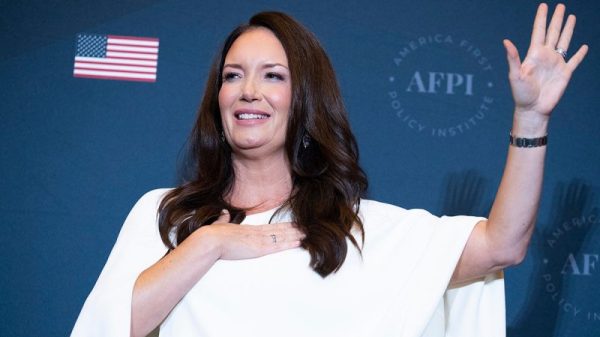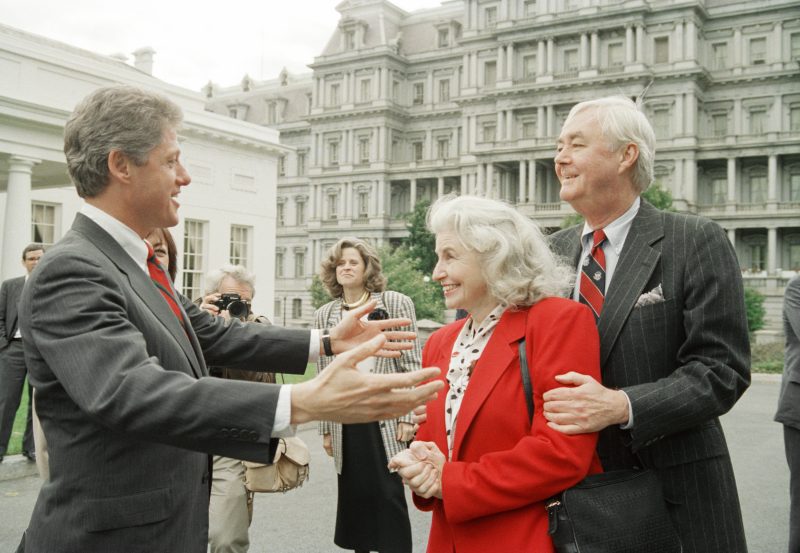Former U.S. Sen. Daniel Patrick Moynihan (D-N.Y), a cerebral politician ever ready with a bon mot, once raised a glass at a celebration and toasted “the other man” in his wife’s life. He was referring not to a paramour or an old flame, but to the 16th-century emperor Babur, founder of the Mughal dynasty in India.
Elizabeth B. Moynihan, who died Nov. 7 at 94, was known in the political world as the savvy campaign manager who helped elect her husband to the Senate in 1976 and hold his seat during 24 years in office. But only part of Mrs. Moynihan’s life was in Washington.
Her “head and heart,” she once said, remained in India, where Moynihan served from 1973 to 1975 as U.S. ambassador. At first Mrs. Moynihan had chafed under the rigid protocols of diplomacy. Yearning to experience the India that lay beyond the ambassador’s residence, she immersed herself in the country’s history and emerged from her studies a renowned scholar of Mughal gardens.
Reading a 1921 translation of Babur’s memoir, “The Baburnama,” Mrs. Moynihan was “gripped by Babur’s adventures, amused by his rowdy escapades with his friends [and] charmed by his descriptions of the flora and fauna of India,” she wrote years later in a recollection.
Perhaps most of all, she was entranced by the emperor’s description of a lotus garden he had built near the city of Dholpur. Scholars assumed that the site, like many Mughal gardens with their geometric wonders and flowing waterways, had been lost to time. Mrs. Moynihan held out hope that it might yet be found.
In 1978, Mrs. Moynihan made one of her many return trips to India. Using “The Baburnama” as a guide, she found her way to the village of Jhor, just outside Dholpur. On a stone terrace where cow dung patties lay drying in the sun, she later told The Washington Post, she pulled back some lentil branches and saw before her what was left of Babur’s lotus pool.
The finding stunned Indian archaeologists and was hailed as “an important archaeological discovery” by the New York Times, which persuaded Mrs. Moynihan, fresh off her triumph, to consent to an interview.
“I don’t give interviews in the States, you know,” she remarked, “because I’m just not interested in answering questions like, ‘What’s it like being married to Pat?’ But this is something on my own that even Moynihan doesn’t know about. He’ll be as pleasantly surprised as everyone else to learn that I could do it.”
In the following years, Mrs. Moynihan identified and documented several other gardens built by Babur. She was the author of the book “Paradise as a Garden: In Persia and Mughal India” (1979) and edited the volume “The Moonlight Garden: New Discoveries at the Taj Mahal” (2000).
The latter documented a study sponsored by the Smithsonian Institution’s National Museum of Asian Art of the Mahtab Bagh, a forgotten garden near the Taj Mahal, the 17th-century tomb in Agra. Mrs. Moynihan led the American team that worked with Indian scholars on the project, which was credited with dramatically expanding modern understanding of the Taj Mahal.
Mrs. Moynihan’s archives, now housed at the Smithsonian, include hundreds of photographs, drawings and plans of gardens associated with Babur in India and across Asia in Pakistan, Afghanistan, Uzbekistan and Iran.
“Scholars are still using her photos and drawings,” Debra Diamond, the Elizabeth Moynihan curator for South Asian and Southeast Asian art at the National Museum of Asian Art, said in an interview. “In some cases those are the only records we have of those gardens.”
During her husband’s Senate career, Mrs. Moynihan paused her research every six years to devote herself to his campaigns. She waved off “honcho consultants and speechwriters and all that,” instead using her well-honed political instincts to help ward off potential challengers and keep her husband above the fray.
Mrs. Moynihan “considered her job essentially to take on the campaign herself” so her husband could “do the work of the Senate,” Mandy Grunwald, a political consultant and friend of the Moynihan family who was a media consultant to three of his senatorial campaigns, said in an interview.
“I think I’ve helped him, and that makes me feel great,” Mrs. Moynihan told the Times. “But we are not a twofer. The people of New York never elected the two of us. After an election, I disappear, and spend a lot of time with Babur.”
Elizabeth Therese Brennan was born in Norwood, Mass., on Sept. 19, 1929, and grew up in nearby Stoughton. Like her husband, she came from an Irish family of limited means, with their fathers largely missing from their lives. Mrs. Moynihan’s mother went to secretarial school and later edited a local newspaper.
After high school, Mrs. Moynihan enrolled at Boston University but dropped out, partly because she ran out of money and partly because she was eager to move to New York.
She was drawn to politics and joined the successful 1954 gubernatorial campaign of W. Averell Harriman, a Democrat. She and Moynihan, who also worked on the campaign, followed Harriman to Albany and shared an office as members of his gubernatorial staff. They married in 1955.
Mrs. Moynihan accompanied her husband to Washington when he joined the Labor Department in the administration of President John F. Kennedy. The couple later moved to Massachusetts, where he taught urban studies and government at Harvard. A lecture on architectural history at the university helped spark Mrs. Moynihan’s interest in the history and construction of gardens.
Mrs. Moynihan declined to return with her husband to Washington when President Richard M. Nixon named him an assistant for urban affairs. “We had a big fight about that,” she remarked years later, referring to his tenure in a Republican administration.
When the Moynihans moved to India, they brought their three children with them. “I was overwhelmed by everything,” Mrs. Moynihan recalled, describing her culture shock. “Pat’s not a career diplomat, and I’m not attached to that whole world. I cried a lot.”
“But I feel I was lucky to be grabbed by something,” she added, referring to her study of Babur and Mughal gardens. “If that happens, then the whole thing falls into place. People I know who didn’t have that experience never got over the crying.”
During their years in Washington, the Moynihans kept a home on Capitol Hill. But they lived for much of their lives in a 19th-century farmhouse in the Upstate New York community of Pindars Corner, where the senator wrote books from an old schoolhouse on the property and Mrs. Moynihan pursued her research in a converted woodshed. On the wall of the shed hung a handwoven Indian cloth bearing the seal of Babur.
Daniel Patrick Moynihan died in 2003 at age 76 of a ruptured appendix. Their son John died in 2004, and their son Timothy died in 2015.
Survivors include their daughter, Maura Moynihan of Manhattan and Woodstock, N.Y., and two grandchildren. Mrs. Moynihan died at her home in Manhattan, according to Tony Bullock, a friend and former chief of staff to her husband. The cause was not immediately available.
Mrs. Moynihan was a longtime board member and donor to the Freer Gallery of Art and the Arthur M. Sackler Gallery, which together make up the Smithsonian’s National Museum of Asian Art. She was a founding trustee of the Leon Levy Foundation in New York, which awards grants in areas including the study and preservation of the ancient world.
Looking back on her work in India, she wrote that the most meaningful lesson she had learned was that “being seized by an idea is one of life’s blessings,” no matter whether “other persons are interested.”
In her home she displayed a life-size papier-mâché likeness of Babur. He sat in a living room chair, clad in a turban and regal vestments, smiling slightly at whoever gazed upon him.







































